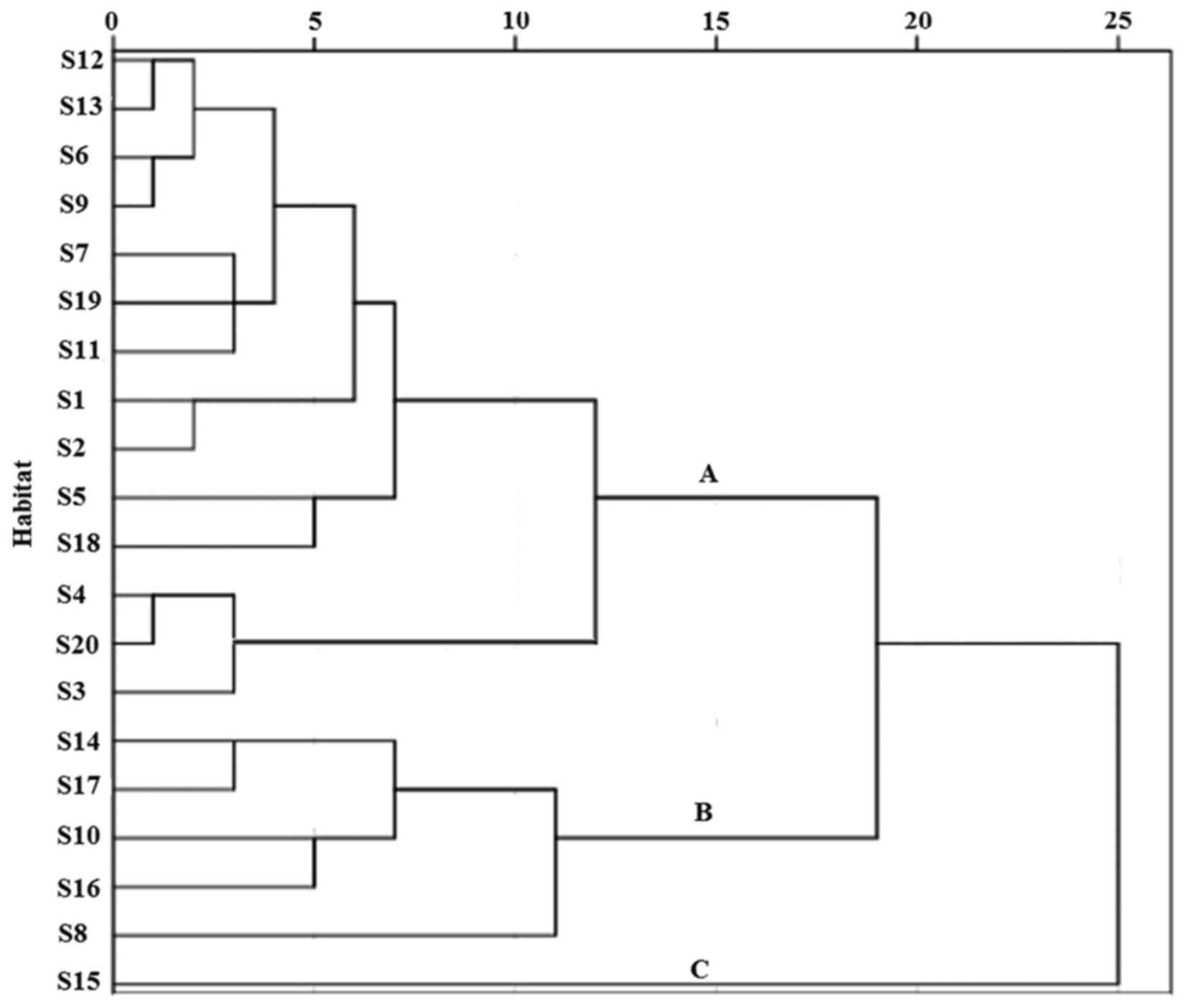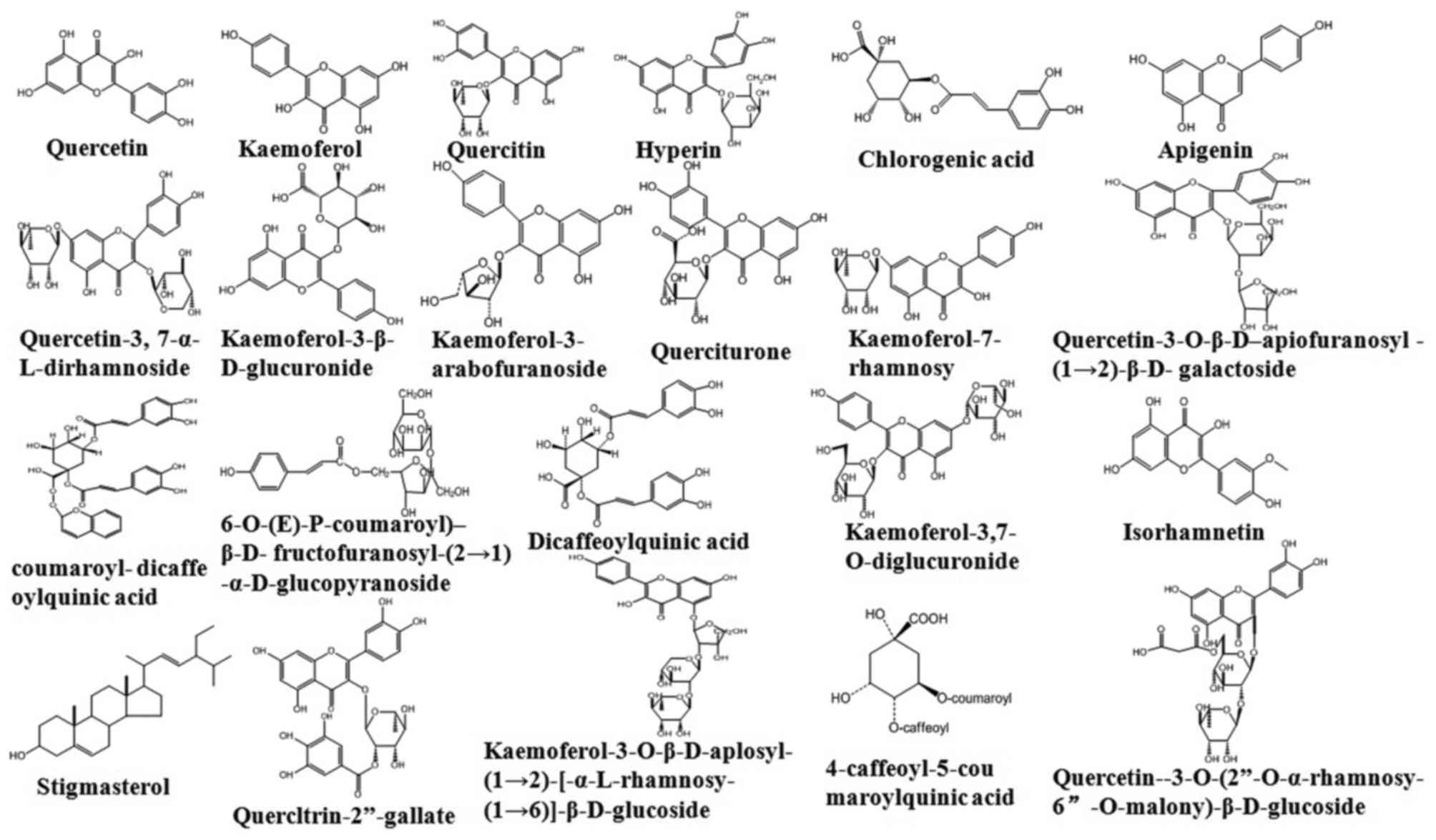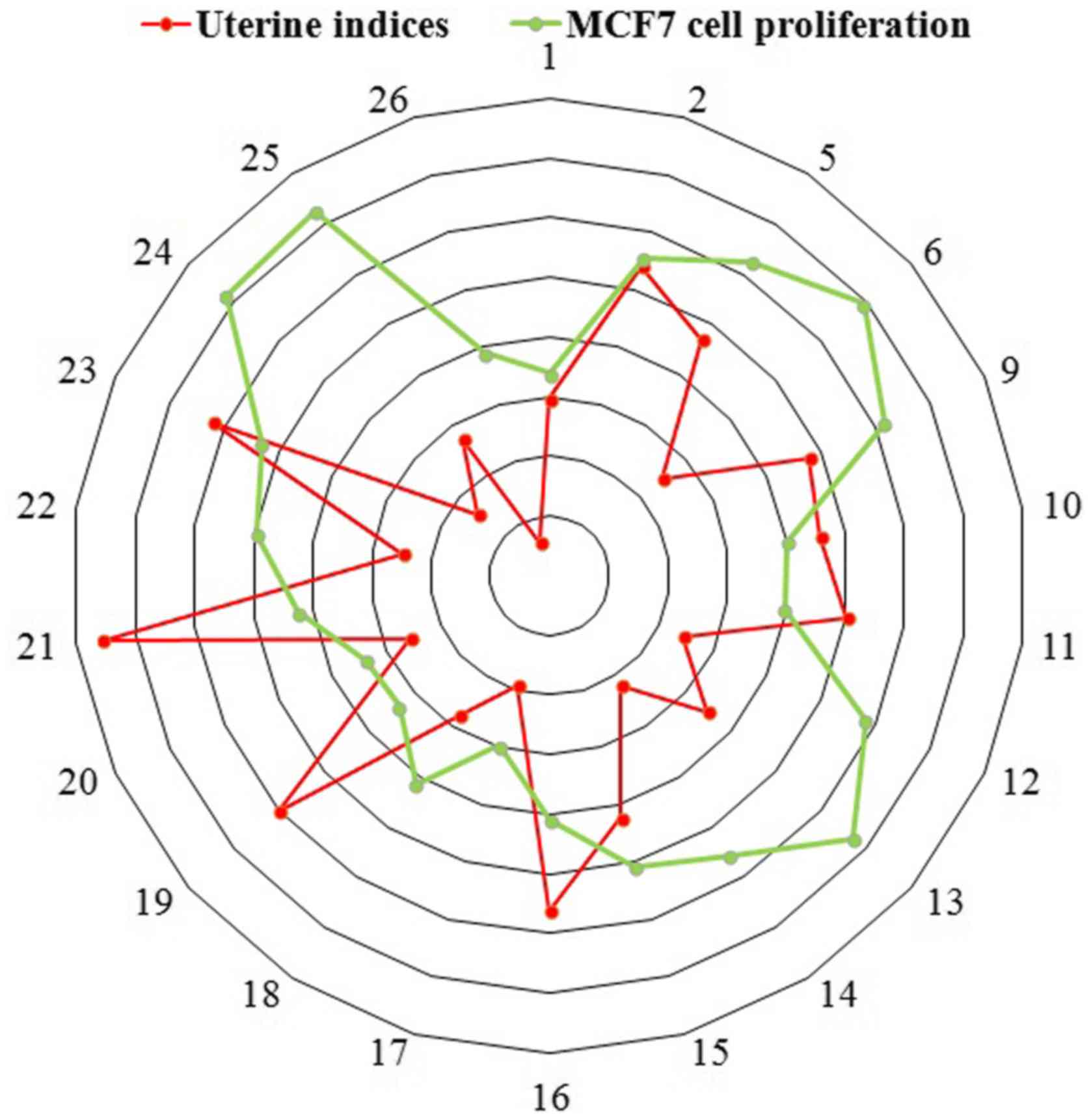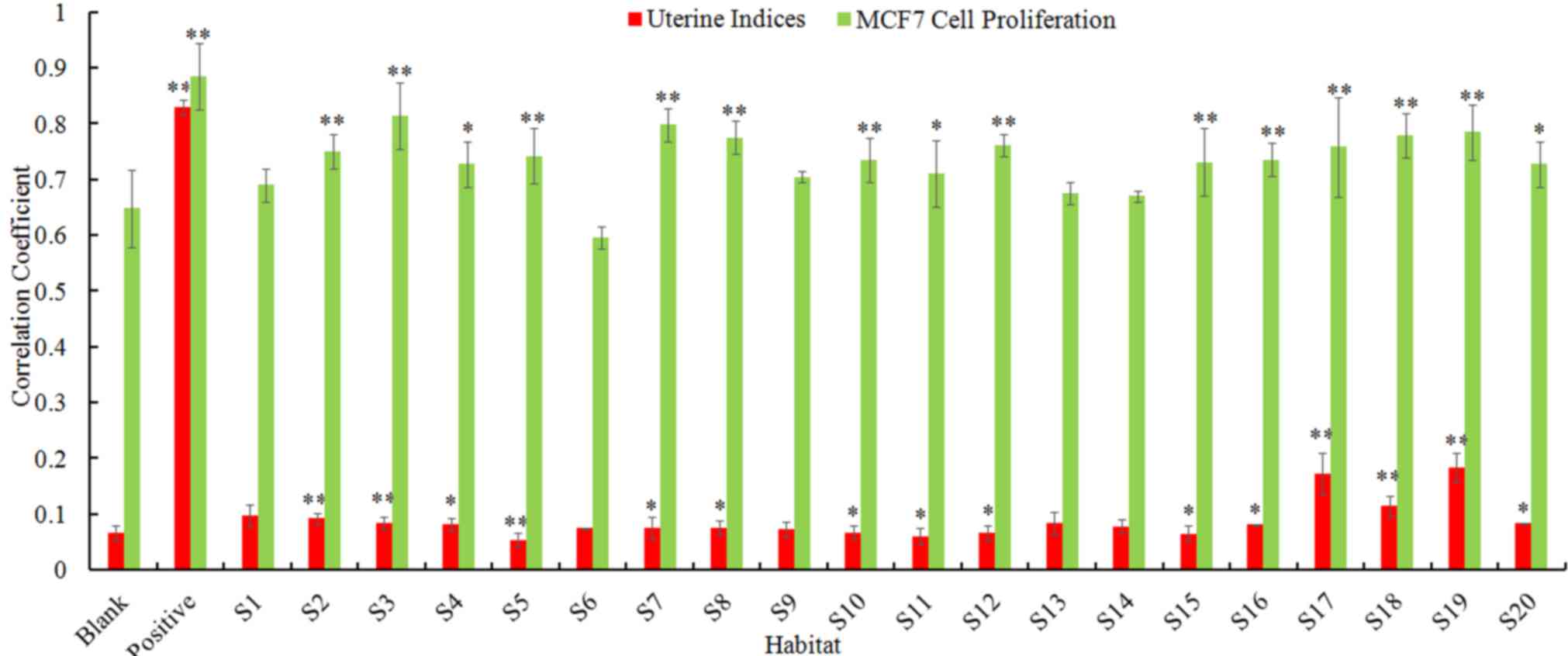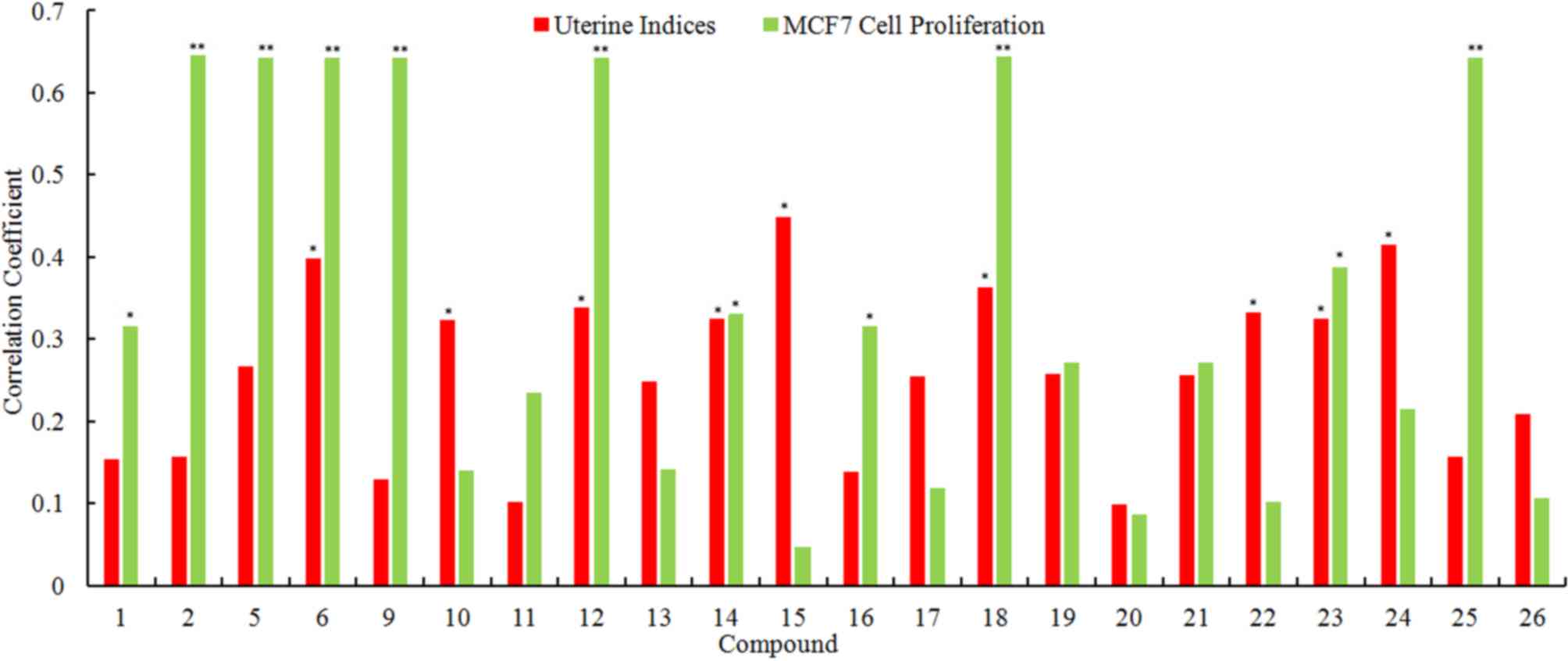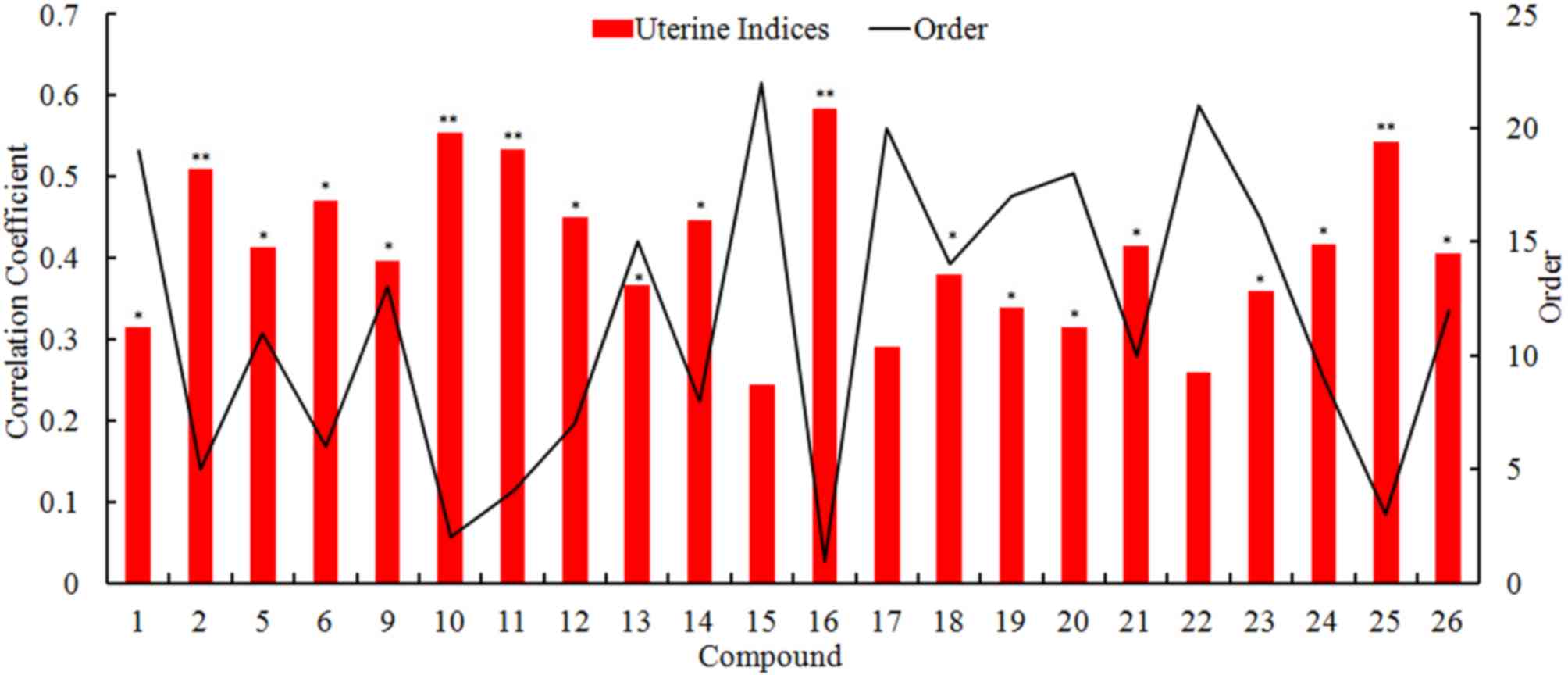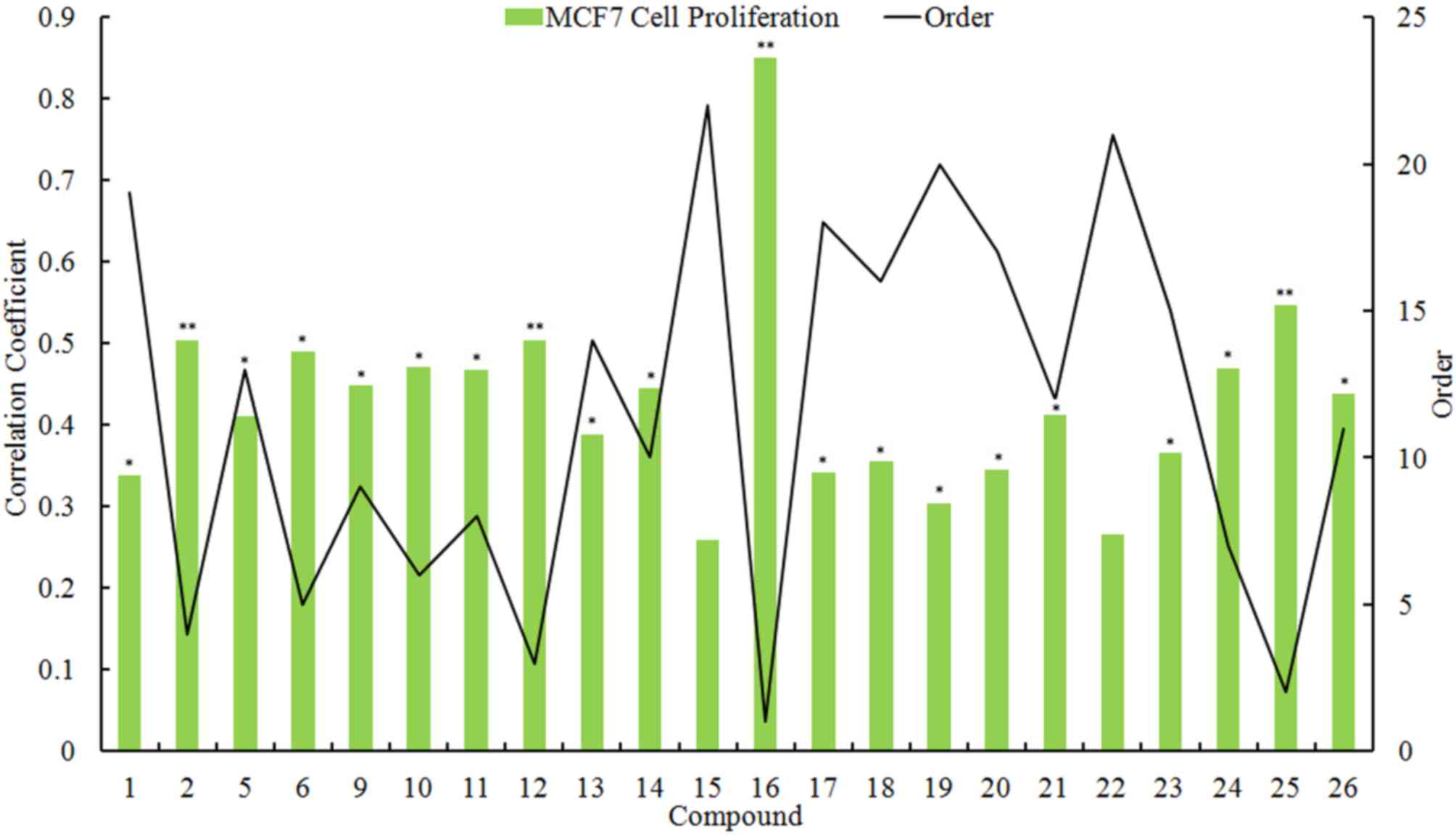|
1
|
An BH, Jeong H, Zhou W, Liu X, Kim S, Jang
CY, Kim HS, Sohn J, Park HJ, Sung NH, et al: Evaluation of the
biological activity of opuntia ficus indica as a tissue- and
estrogen receptor subtype-selective modulator. Phytother Res.
30:971–980. 2016. View
Article : Google Scholar : PubMed/NCBI
|
|
2
|
van de Schans MG, Vincken JP, de Waard P,
Hamers AR, Bovee TF and Gruppen H: Glyceollins and
dehydroglyceollins isolated from soybean act as SERMs and ER
subtype-selective phytoestrogens. J Steroid Biochem Mol Biol.
156:53–63. 2016. View Article : Google Scholar : PubMed/NCBI
|
|
3
|
Wang Z, Xia Q, Liu X, Liu W, Huang W, Mei
X, Luo J, Shan M, Lin R, Zou D and Ma Z: Phytochemistry,
pharmacology, quality control and future research of Forsythia
suspensa (Thunb.) Vahl: A review. J Ethnopharmacol. 210:318–339.
2018. View Article : Google Scholar : PubMed/NCBI
|
|
4
|
Shu Y, Liu Z, Zhao S, Song Z, He D, Wang
M, Zeng H, Lu C, Lu A and Liu Y: Integrated and global
pseudotargeted metabolomics strategy applied to screening for
quality control markers of Citrus TCMs. Anal Bioanal Chem.
409:4849–4865. 2017. View Article : Google Scholar : PubMed/NCBI
|
|
5
|
Yang B, Wang Y, Shan L, Zou J, Wu Y, Yang
F and Zhang Y, Li Y and Zhang Y: A novel and practical
chromatographic ‘Fingerprint-ROC-SVM’ strategy applied to quality
analysis of traditional chinese medicine injections: Using KuDieZi
injection as a case study. Molecules. 22:E12372017. View Article : Google Scholar : PubMed/NCBI
|
|
6
|
Zhuo L, Peng J, Zhao Y, Li D, Xie X, Tong
L and Yu Z: Screening bioactive quality control markers of
QiShenYiQi dripping pills based on the relationship between the
ultra-high performance liquid chromatography fingerprint and
vascular protective activity. J Sep Sci. 40:4076–4084. 2017.
View Article : Google Scholar : PubMed/NCBI
|
|
7
|
Spagnuolo P, Rasini E, Luini A, Legnaro M,
Luzzani M, Casareto E, Carreri M, Paracchini S, Marino F and
Cosentino M: Isoflavone content and estrogenic activity of
different batches of red clover (Trifolium pratense L.) extracts:
An in vitro study in MCF-7 cells. Fitoterapia. 94:62–69. 2014.
View Article : Google Scholar : PubMed/NCBI
|
|
8
|
Wang DD, Liang J, Yang WZ, Hou JJ, Yang M,
Da J, Wang Y, Jiang BH, Liu X, Wu WY and Guo DA:
HPLC/qTOF-MS-oriented characteristic components data set and
chemometric analysis for the holistic quality control of complex
TCM preparations: Niuhuang Shangqing pill as an example. J Pharm
Biomed Anal. 89:130–141. 2014. View Article : Google Scholar : PubMed/NCBI
|
|
9
|
Hernaez R and Thrift AP: High negative
predictive value, low prevalence, and spectrum effect: Caution in
the interpretation. Clin Gastroenterol Hepatol. 15:1355–1358. 2017.
View Article : Google Scholar : PubMed/NCBI
|
|
10
|
Li W, Sun X, Liu B, Zhang L, Fan Z and Ji
Y: Screening and identification of hepatotoxic component in Evodia
rutaecarpa based on spectrum-effect relationship and UPLC-Q-TOFMS.
Biomed Chromatogr. 30:1975–1983. 2016. View
Article : Google Scholar : PubMed/NCBI
|
|
11
|
Zheng Q, Zhao Y, Wang J, Liu T, Zhang B,
Gong M, Li J, Liu H, Han B, Zhang Y, et al: Spectrum-effect
relationships between UPLC fingerprints and bioactivities of crude
secondary roots of Aconitum carmichaelii Debeaux (Fuzi) and its
three processed products on mitochondrial growth coupled with
canonical correlation analysis. J Ethnopharmacol. 153:615–623.
2014. View Article : Google Scholar : PubMed/NCBI
|
|
12
|
Shi Z, Liu Z, Liu C, Wu M, Su H, Ma X,
Zang Y, Wang J, Zhao Y and Xiao X: Spectrum-effect relationships
between chemical fingerprints and antibacterial effects of
lonicerae japonicae flos and lonicerae flos base on UPLC and
microcalorimetry. Front Pharmacol. 7:122016. View Article : Google Scholar : PubMed/NCBI
|
|
13
|
Chen Y, Yu H, Wu H, Pan Y, Wang K, Liu L,
Jin Y and Zhang C: Tracing novel hemostatic compounds from heating
products of total flavonoids in Flos Sophorae byspectrum-effect
relationships and column chromatography. J Sep Sci. 38:1691–1699.
2015. View Article : Google Scholar : PubMed/NCBI
|
|
14
|
Liu X, Wang XL, Wu L, Li H, Qin KM, Cai H,
Pei K, Liu T and Cai BC: Investigation on the spectrum-effect
relationships of Da-Huang-Fu-Zi-Tang in rats by UHPLC-ESI-Q-TOF-MS
method. J Ethnopharmacol. 154:606–612. 2014. View Article : Google Scholar : PubMed/NCBI
|
|
15
|
Xie RF, Zhou X, Shi ZN, Li YM and Li ZC:
Study on spectrum-effect relationship of rhizoma Rhei, cortex
Magnoliae Officinalis, fructus Aurantii immaturus and their
formula. J Chromatogr Sci. 51:524–532. 2013. View Article : Google Scholar : PubMed/NCBI
|
|
16
|
Ding JX, Li WL, Bai J and Ji YB: Studies
on spectrum-effect correlation of mimic estrogenic activity of
Cuscuta chinensis. Chin Pharm J. 337–340. 2013.(In Chinese).
|
|
17
|
Sun SL, Guo L, Ren YC, Wang B, Li RH, Qi
YS, Yu H, Chang ND, Li MH and Peng HS: Anti-apoptosis effect of
polysaccharide isolated from the seeds of Cuscuta chinensis Lam on
cardiomyocytes in aging rats. Mol Biol Rep. 41:6117–6124. 2014.
View Article : Google Scholar : PubMed/NCBI
|
|
18
|
Kang J, Li X, Geng J, Han L, Tang J, Jin Y
and Zhang Y: Determination of hyperin in seed of Cuscuta chinensis
Lam. by enhanced chemiluminescence of CdTe quantum dots on
calcein/K3Fe(CN)(6) system. Food Chem. 134:2383–2388. 2012.
View Article : Google Scholar : PubMed/NCBI
|
|
19
|
Yang L, Chen Q, Wang F and Zhang G:
Antiosteoporotic compounds from seeds of Cuscuta chinensis. J
Ethnopharmacol. 135:553–560. 2011. View Article : Google Scholar : PubMed/NCBI
|
|
20
|
Liao JC, Chang WT, Lee MS, Chiu YJ, Chao
WK, Lin YC, Lin MK and Peng WH: Antinociceptive and
anti-inflammatory activities of Cuscuta chinensis seeds in mice. Am
J Chin Med. 42:223–242. 2014. View Article : Google Scholar : PubMed/NCBI
|
|
21
|
Yang S, Xu X, Xu H, Xu S, Lin Q, Jia Z,
Han T, Zhang H, Zhang Y, Liu H, et al: Purification,
characterization and biological effect of reversing the kidney-yang
deficiency of polysaccharides from semen cuscutae. Carbohydr Polym.
175:249–256. 2017. View Article : Google Scholar : PubMed/NCBI
|
|
22
|
Zou D, Wang J, Zhang B, Xie S, Wang Q, Xu
K and Lin R: Analysis of chemical constituents in Wuzi-Yanzong-Wan
by UPLC-ESI-LTQ-Orbitrap-MS. Molecules. 20:21373–21404. 2015.
View Article : Google Scholar : PubMed/NCBI
|
|
23
|
Chen ML, Miao L, Cao J, Ip SP and Che CT:
Quantitative analysis of biologically active ingredients of five
seeds combo by liquid chromatography-quadrupole time-of-flight mass
spectrometry for quality control of commercial herbal product. J
Sep Sci. 35:1612–1618. 2012. View Article : Google Scholar : PubMed/NCBI
|
|
24
|
Ding JX: Correlation of researches on the
fingerprints and estrogenic activity of Cuscuta chinensis. Master's
degree thesis of Harbin University of Commerce. 18–19. 2013.(In
Chinese).
|
|
25
|
Chatkupt TT, Libal NL, Mader SL, Murphy SJ
and Saunders KE: Effect of continuous trio breeding compared with
continuous pair breeding in ‘Shoebox’ caging on measures of
reproductive performance in Estrogen receptor knockout mice. J Am
Assoc Lab Anim Sci. 2018. View Article : Google Scholar :
|















